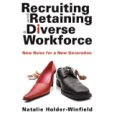 NCRW Panel on Corporate and Academic Diversity – Post#2
NCRW Panel on Corporate and Academic Diversity – Post#2
Moderator Ana Duarte McCarthy (pictured) leads the next bit of the session by noting that less than 3% of senior management and corporate officers are people of color. The numbers for women are extremely low. What is it that isn’t working? And what can we do about it?
Melinda Wolfe responds: “Until organizations recognize that women bear children and are primarily the caretakers for them, there will continue to be barriers for women to move up. Some women might come off the track; there are times when women take the scenic route but want to get back on and make a difference, but our systems don’t allow that. There are still huge underlying unconscious bias factors that go on in these institutions, that without critical mass, will continue. In some ways we’re at a dangerous inflection point, in that there are now more people who’ve heard about diversity and think that they get it. But they don’t. Because they think that they get it, their behaviors are more insidious.”
Anne Erni responds: “Several years ago, several of us worked with Sylvia Ann Hewlett on her Brain Drain study. We found that nearly 43% of women in corporations want to step off the track for a while, and 93% of them want to get back on. But less than half are successful in finding fulfilling fulltime roles. So some firms created models, like Lehman’s Encore program, to address. It’s been successful. The key is getting men to empathize. Many of these guys marry women on the Street [Wall Street, that is – GWP], so they are more likely to get it. There were also incentives: people would get paid for referring women who wanted to on-ramp.â€
Ah, how money talks. Poignant conversation about race going on next. A woman from the audience comments that she’s often the only African American student in the room. How do we move past that? Rosemary Cocetti shares a personal story about her son, who is an athlete, and a great writer, and who experienced straight out racism at college. His professor didn’t believe that a paper he submitted was his. Ironic, given that Cocetti is the diversity officer on campus. Actually, less ironic, more telling of how far we have to go. On the corporate front, how do coworkers deal with it the first time they see a colleague wearing a head scarf? The dilemma of being the first.
Stomachs are rumbling and the panel is wrapping up. A question asked earlier by Meryl Kaynard, Lehman Brothers, who is sitting next to me, has yet to be addressed. Rats, as this was my question too. The question: What’s going on in terms of Generations X and Y? And I want to know: to what extent does the comfort with a more global community–the one in which we’ve come of professional age–shape our expectations for inclusion here at home?
Ok, signing off now. Fear of carpel tunnel kicking in!










